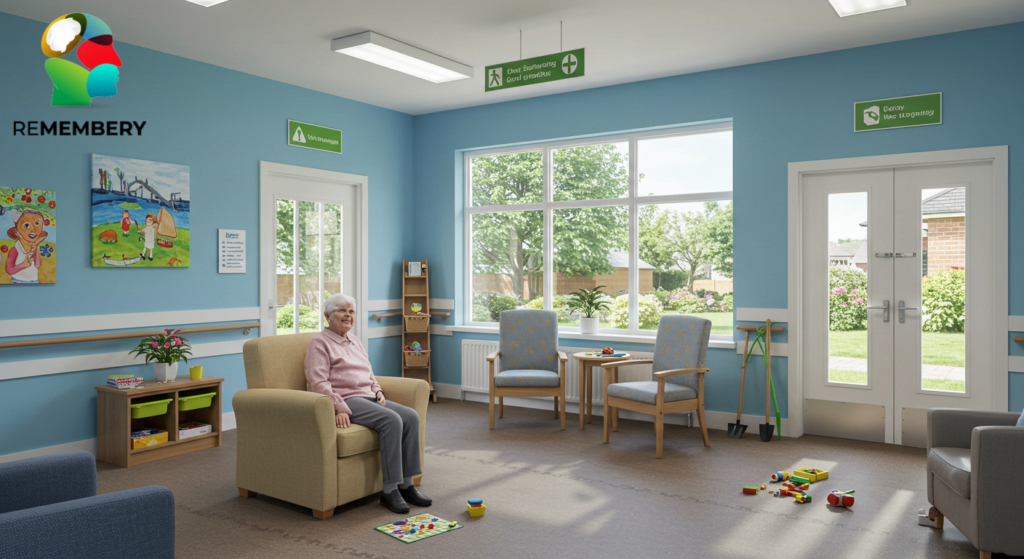Individuals suffering from cognitive decline require a dementia-friendly setting that promotes safety, independence, and comfort. As dementia progresses, issues such as memory loss, confusion, and difficulty traversing environments increase. Adapting to the home environment can help dementia sufferers cope and improve their well-being. Simple but effective changes, such as regular routines with daily reminders, better lighting, and engaging activities at home, can greatly enhance dementia sufferers’ quality of life.
Technological aids, such as reminder apps and memory support tools like the recall app, can help caregivers keep routines while also providing piece of mind. Furthermore, employing the best light therapy lights for dementia sufferers will help them sleep better and feel less anxious. Caregivers can create a place that promotes independence and comfort while minimizing confusion and distress by carefully modifying the surroundings.
Optimizing Lighting for Better Orientation and Comfort
Lighting is important in providing a safe and effective environment for dementia sufferers. Poor illumination can cause disorientation, irritation, and even accidents. Natural daylight improves cognitive performance and mood, thus getting as much sunlight as possible is recommended. However, artificial lighting should be explored, particularly during the evening hours when disorientation, known as sundowning, tends to develop.
Installing the best light therapy lamps for dementia patients can help regulate circadian rhythms and reduce nighttime restlessness. These lamps simulate natural daylight, which is essential for stabilizing sleep patterns. Motion-sensor lights in hallways, bathrooms, and bedrooms can enhance nighttime safety by preventing falls. It is also important to reduce glare and shadows, as they can create illusions that may cause distress or confusion. Ensuring that all areas of the home are well-lit provides reassurance and improves navigation for dementia patients.
Creating a Safe and Organized Home Layout
A well-structured home environment helps dementia patients move around independently while minimizing risks. Clutter and obstacles can lead to falls and increased confusion, making maintaining a simple and organized space crucial. Removing unnecessary furniture, securing loose rugs, and installing handrails in hallways and bathrooms can greatly enhance safety.
Labeling different areas of the home with clear, bold text or images can assist with recognition. For example, placing a large sign on the bathroom door helps individuals locate essential areas more easily. Color contrast is another useful tool—painting door frames or furniture in contrasting colors can help dementia patients differentiate between spaces. A dementia environment that is designed with simplicity and accessibility in mind promotes independence and reduces frustration.
Establishing a Routine with Daily Reminders
Routine is important for people with dementia because it gives structure and decreases confusion. Daily reminders help reinforce critical chores including food planning, medication regimens, and personal hygiene habits. Written notes, visual calendars, and audio reminders can all contribute to a sense of order.
Technology is becoming increasingly vital in dementia care, with reminder programs such as the recall app delivering timely alerts for important tasks. Digital assistants can also be trained to provide voice prompts for daily tasks. Keeping regularly used objects in specified areas, such as keeping keys and spectacles in the same place every day, aids memory recall. Dementia patients can maintain a sense of autonomy by sticking to a consistent schedule and using all of their remembered tools.
Encouraging Meaningful Activities for Engagement
Keeping dementia patients engaged in activities is essential for their emotional and cognitive well-being. Boredom and inactivity can lead to increased agitation and anxiety, making it crucial to incorporate activities for dementia patients at home that are enjoyable and mentally stimulating. Activities should be tailored to the individual’s interests and abilities, ensuring they feel a sense of accomplishment and purpose.
Music therapy is particularly effective, as familiar songs can evoke positive memories and improve mood. Simple tasks like gardening, painting, or crafting can provide sensory stimulation and a sense of achievement. Walking and chair yoga are two simple physical exercises that enhance mobility and reduce restlessness. Caregivers should encourage participation in modest domestic tasks like folding laundry or preparing the table to foster independence. Caregivers can improve the quality of life for dementia patients by introducing meaningful activities at home.
Utilizing Technology for Support and Safety
Modern technology is extremely helpful to dementia patients and their caregivers. Assistive technology, such as reminder applications and memory aides, help to reinforce daily routines and reduce the stress of forgetting. The recall app can be used to set medication reminders, schedule appointments, and manage crucial tasks, giving patients and caregivers confidence.
GPS monitoring devices can be useful for people who wander, assuring their safety and assisting caretakers in finding them if necessary. Smart home automation solutions, which include voice-activated assistants, may aid with daily tasks, control lighting, and even issue safety notifications. Using easily remembered digital tools to save vital information, such as emergency contacts and medical history, can also be quite beneficial. By incorporating technology into the dementia environment, caregivers can provide improved support while allowing dementia patients to preserve their independence for as long as possible.
Creating a Calming and Familiar Atmosphere
A dementia-friendly house should feel welcoming and familiar, as familiarity alleviates anxiety and promotes comfort. Personal touches such as family photos, familiar furnishings, and valued possessions contribute to a calming atmosphere. Soft, warm hues in the home can help you relax, as opposed to harsh or too bright tones, which can be stressful.
Excessive noise can cause confusion and anxiety, so avoiding distractions is crucial. Background noise from televisions and loud discussions should be kept to a minimum, especially in rest areas. Providing designated quiet spaces for people to relax and unwind improves their emotional well-being.
Maintaining a healthy temperature and enough ventilation can help create a comfortable living environment. Caregivers can make the home more dementia-friendly by adding soothing features and lowering stress.
Conclusion
Changing someone’s living situation with dementia requires careful planning and intentional changes. Improving lighting with the best light therapy lamps for dementia sufferers, organizing spaces for easy navigation, and providing regular reminders all help people preserve their independence. Participating in dementia-specific activities at home and utilizing assistive technology, such as the Remember application, can help to enhance quality of life.
Caregivers can provide a controlled, peaceful, and familiar dementia environment to reduce disorientation and increase feelings of security. Making these changes allows dementia sufferers to feel more at ease in their surroundings, which leads to better emotional and cognitive well-being.








